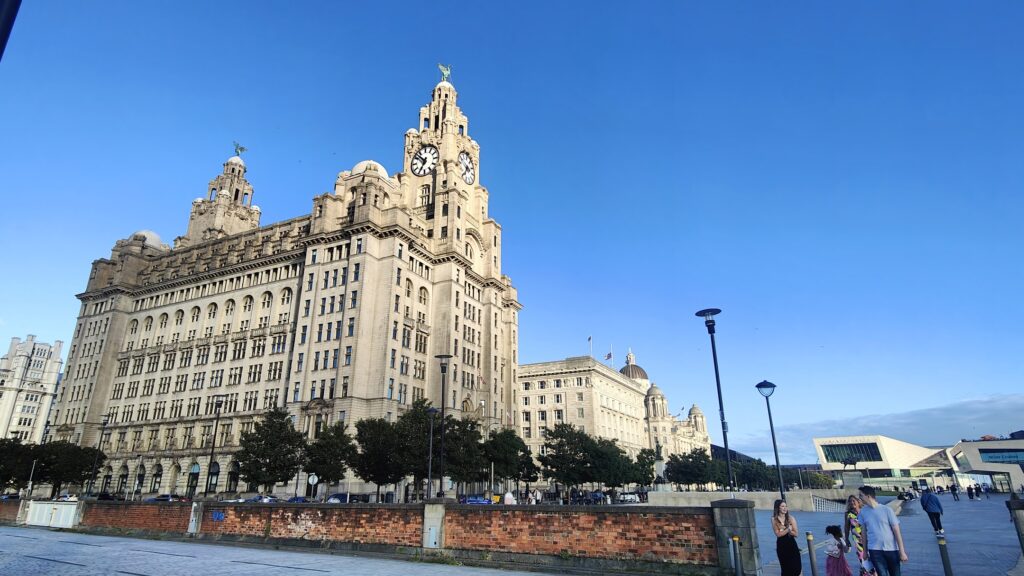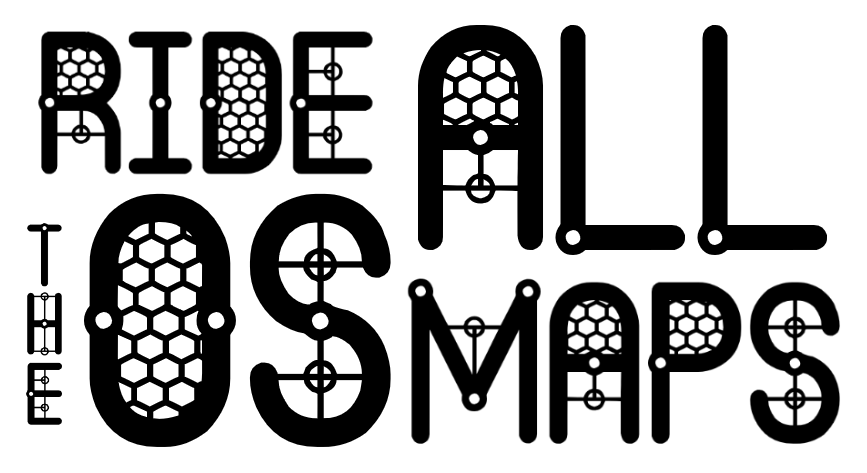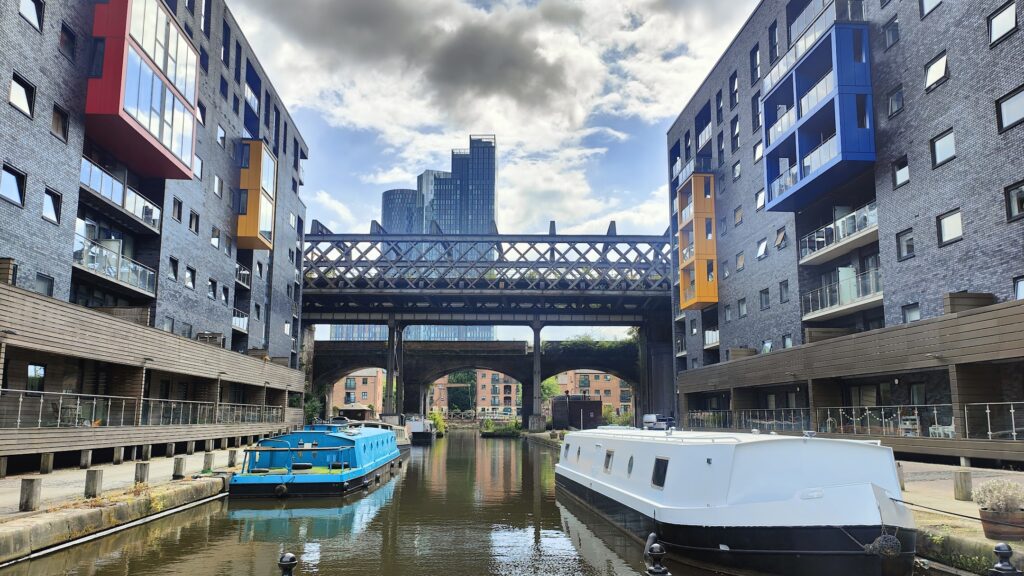
I was back in Manchester, an hour from home on a regular train that stops in my village. My goal today was the Isle of Man. But not the easy way. I was intent on cycling along my WNW line to the Ribble estuary, and then dropping south to Southport, from where there are regular trains in to Liverpool. The ferry for Douglas would be leaving from the new IOM ferry terminal, close to the famous Liver Building on the banks of the Mersey, at 7.30pm. Jenni would be waiting there for me. I should have plenty of time.
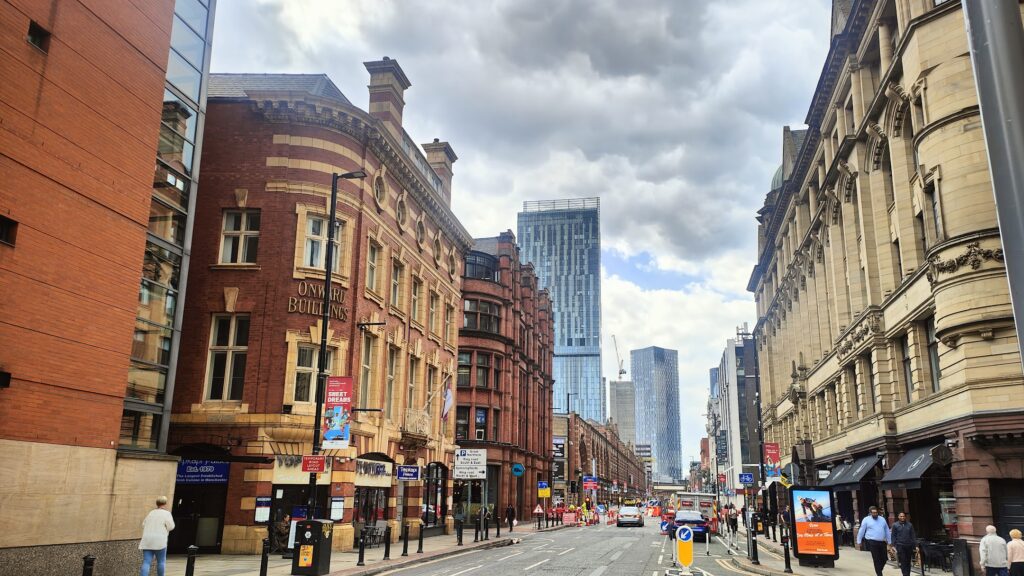
My first task was to navigate my way though, and away from, central Manchester. It is a large and impressive city these days, very much a place under rapid transformation and it seems like the only way is up. Literally. There are tall buildings sprouting in every direction you looked. And my understanding is that they are mostly intended to be residential. It makes Manchester something of a unique case. It certainly has a buzz about it and very much feels like England’s northern capital.
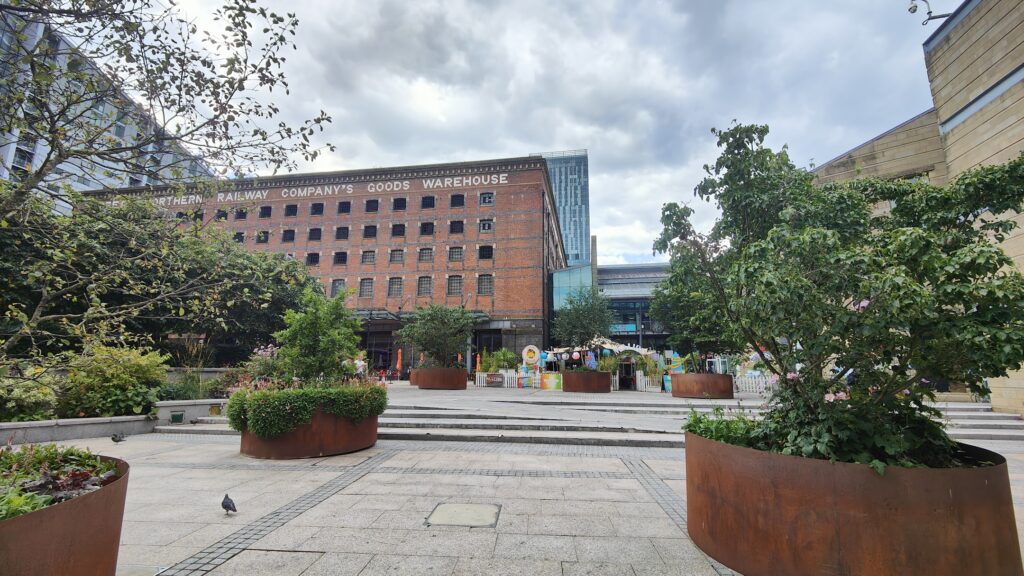
My dad and his parents and grandparents all had their roots in this city. My grandparents had working class upbringings and my dad and his brother were considered very fortunate to attend the esteemed Manchester Grammar School. None of them would recognise the city as it is today. The street layout and some of the grander, older buildings may be the same; but the development of the last twenty years has created a new, modern city that looks forward as much as it looks back at its proud industrial past. It feels big and important. I didn’t have time to spend being a tourist today, but it struck me that it was about time I did just that. It’s a place I pass through a lot on my way to or from somewhere else by train. I use the airport for almost all my flights. I also attend major sporting events here, and the occasional concert. But I haven’t had a proper look around on foot, or visited the museums or galleries. A day trip from home would be easy. So much to do!

Anyway, I found much to photograph this morning in the sunshine (although not the iconic town hall, which is wrapped up under restoration) before I made my way out along some pretty decent new cycle lanes towards somewhat less salubrious Salford. Once away from Manchester City Centre, things got back to being drab and suburban. It varied in appearance from run down terraced streets and dreary, light industry to attractive, leafy residential suburbs on the far side of Eccles (of the cake fame).
I was looking for a cycling rail trail about here somewhere, NCN 55, and was delighted when I discovered a broad, paved greenway that stretched away for miles exactly where I wanted. In fact, I was having so much fun that miles later I somehow missed a point where the path branched into two, and when I unexpectedly crossed a motorway bridge I thought I should check my location. I thought I was heading for Wigan, slightly to the south of my straight line. It turned out the path had delivered me instead to the edge of Bolton, some distance away. It wasn’t a disaster, because this was actually a very viable alternative, taking me just north of my straight line instead. I don’t know either town, so while I lost with one hand, I won with the other. Whether I would have suffered a puncture in Wigan I will never know. But I did in Bolton, unfortunately, and that set me back a little. It was my first of the entire trip.

I fixed it in a park in a rather scruffy part of town, south of the centre. I sat on a bench next to a five a side court where three Muslim teenagers, dressed for Friday prayers, we’re kicking a football around. Bolton has a long and proud football heritage (unlike Wigan which is a rugby league town), and the likes of Nat Lofthouse graced the Cup Final back in the 1950s when they were among the best teams in the land. Nat Lofthouse scored 30 goals in 33 appearances for England. He was born in Bolton, and he died here. His only major honour was the FA Cup in 1958, when Bolton beat Manchester United 2-0 in the final, three months and three rounds after United had lost much of their team in the terrible Munich air disaster. The two teams have gone on to enjoy wildly different fortunes in more recent times; but it was good to see some of today’s local youth out kicking a ball.
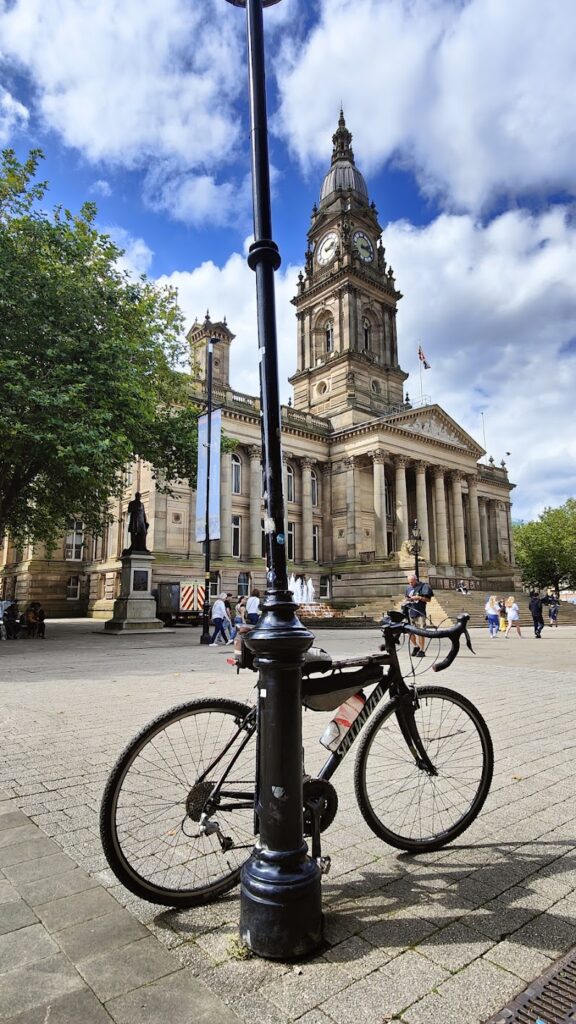
Puncture fixed, I rolled into the town centre and feasted my eyes on two of its highlights: the huge and grand Victorian town hall, right in the middle of the pedestrianised shopping area, and a statue of another local legend, TV steeplejack Fred Dibnah. The town hall, with its tall clock tower and it’s twin fountains, speaks of a time when this northern town was at the height of its industrial strength, one of many such towns in and around the north west. Today, the place feels like it doesn’t quite know what it is any more. It nestles in the shadow of the West Pennine Moors, attractive rugged country, and the outer suburbs, uphill from the centre of town, were pleasant enough. The rest of it seems to be rather struggling to me; a real contrast to the streets of central Manchester just a short train ride away.
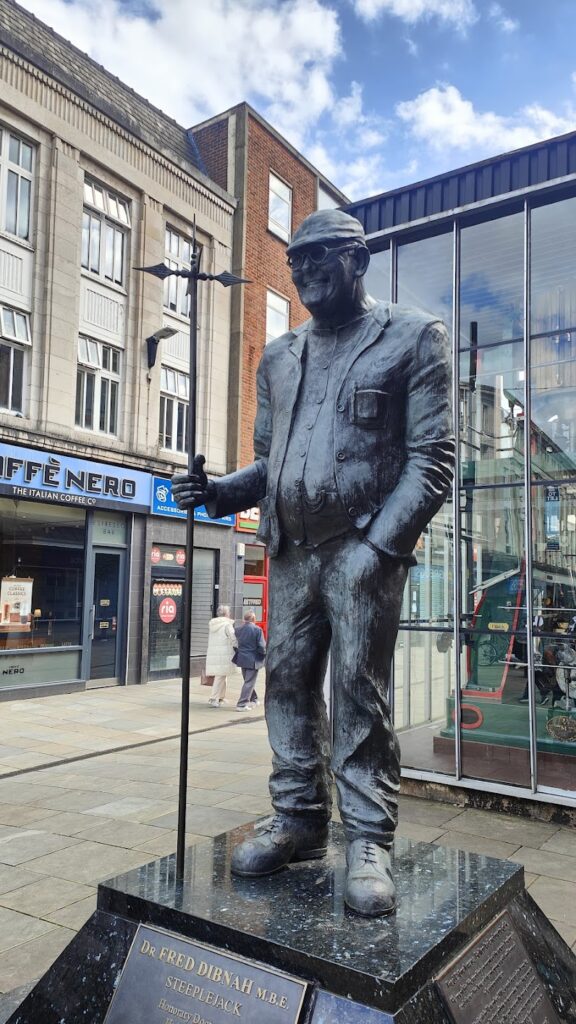
But there is still some pride in the people. While I was admiring the larger than life statue of Fred Dibnah – a man who personified Bolton’s prouder days if ever there was – a rather rough-looking woman stared at me, as if deciding whether I belonged in her town. But then she said “E wer a great man, Fred. Ah lived near im and e alwis ad time for’t kiddies.” At least I think that’s what she said. The Bolton accent is strong.
I climbed out of Bolton and rode past the prominent radio transmitter on Winter Hill over to Horwich, it’s smaller neighbour (and now home to the football ground), which seemed a more well to do place, with a host of nice looking pubs. Just beyond here you reach the wooded hills leading up to Rivington Pike. Lord Leverhulme, the industrialist, philanthropist and politician (1851 – 1925) once had a home here that now lies in ruins. He was the son of a Bolton grocer and gave the land at Rivington, including the gardens and the tower on the hilltop, to the people of Bolton. He was also a supporter of the right to roam, and there is free access to all of this area. I found a popular tea room by a large car park, which was perfectly placed for my needs. I sat out in the sun and planned the rest of my way to the sea.
From here, the route was fiddly, involving many twists and turns through the villages on the flatter land between the hills and the coast. It was decent cycling, but nothing really memorable. There was traffic about, but not so much to make it a problem. I made good progress and arrived where the road ran out at Hesketh Bank, a few miles to the north of Southport, where salt marsh stretched away into the distance. Somewhere over there was the River Ribble estuary. The only clue was the tiny silhouette of Blackpool Tower, many miles further north, rising from an otherwise flat landscape.
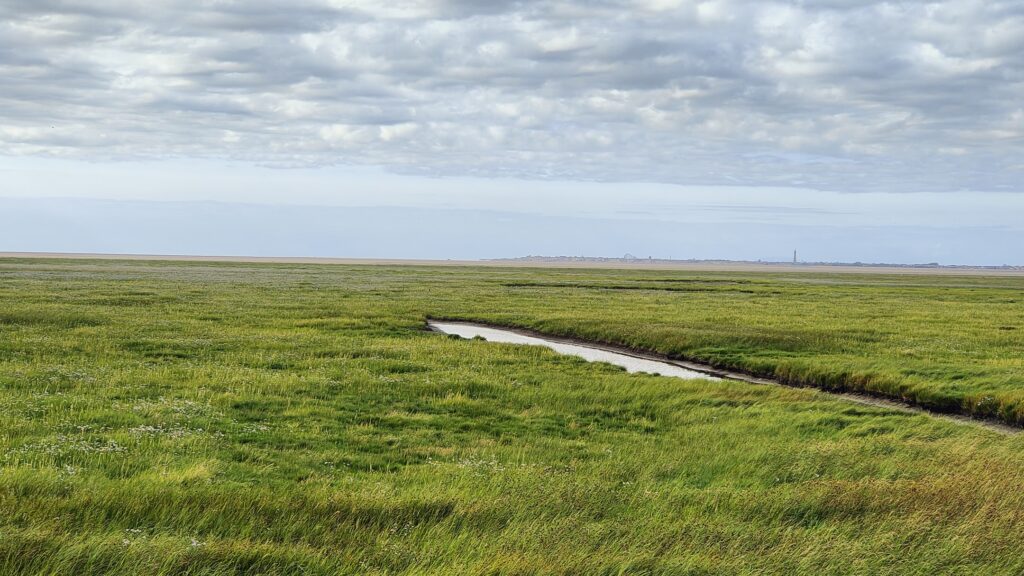
My ride into Southport from here began on a quiet, straight road past farms and remote houses in an area that felt very out of the way. In a few miles that all changed as I gained the shore road in towards Southport, which was lined with queuing cars trying to get away from a day at the seaside. I was going against the flow along a cycle path, and was glad of it. I reached Southport by the pier, which, like the sea here, goes out a very long way. It also goes in a long way towards the genteel Victorian town centre, which sits a little inland beyond the Marine Lake. I was suddenly in the thick of things, with seaside activity all around, but just as suddenly whisked away on the next train south to Liverpool. I didn’t mind. I have made a good number of visits to Southport over the years, especially when I had family here, and my business today lay elsewhere, in places I knew much less well.

I thought I still had plenty of time, but then the train got stuck in a station north of Liverpool. There were intruders on the line at Bootle and all power to the network was off. Suddenly I was worried if I would make it. But after perhaps ten anxious minutes it all returned to normal and off we went. The clock faces of the iconic Liver Building (the largest in Britain) said I was on time arriving at the sunny Pier Head, where I found Jenni and boarded the ferry to the Isle of Man and the next phase of this unlikely adventure.
